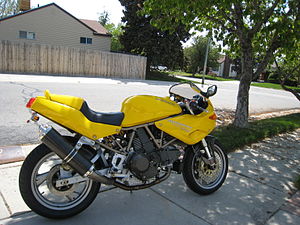Ducati SuperSport

1998 Ducati 900 SS/CR – one of only 200 made
|
|
| Manufacturer | Ducati |
|---|---|
| Also called | SS |
| Production | 1972–1981 1988–2007 |
| Predecessor | Pantah |
| Class | Sportbike |
| Engine | 904 cc SOHC 2-valve Desmo 90° V-twin |
| Bore / stroke | 92 mm × 68 mm (3.6 in × 2.7 in) |
| Compression ratio | 9.2:1 |
| Power | 80 hp @ 7,500 rpm |
| Torque | 57 ft·lbf (77 N·m) @ 6,500 rpm |
| Transmission | Close ratio 6-speed |
| Suspension | Showa |
| Brakes | Brembo |
| Wheelbase | 1988: 1310 mm 1999: 1395 mm (55.6 in) |
| Seat height | 820 mm (32.3 in) |
| Weight | 1988: 198 kg 1999: 188 kg (414 lb) (dry) |
| Fuel capacity | 16 L (3.5 imp gal; 4.2 US gal), including 4 L (0.88 imp gal; 1.1 US gal) reserve |

Ducati 400SS
|
|
| Manufacturer | Ducati |
|---|---|
| Also called | 350/400 Supersport, 400 Junior |
| Production | 1991–1993 (350) 1989–1997 (400) 1993-1999 (600) |
| Class | Sport bike |
| Engine | 349 cc (21.3 cu in), 398 cc (24.3 cu in) and 583 cc (35.6 cu in) 4-stroke air-cooled desmodromic 90° V-twin |
| Top speed | 180 km/h (110 mph) (350 and 400) |
| Power | 36 hp (27 kW) @10,500 rpm (350) 42 hp (31 kW) @10,000 rpm (400) 53 hp (40 kW) @8,250 rpm (600) |
| Transmission | Dry clutch (1991), wet clutch (1992–1998) 6-speed, chain drive |
| Brakes | Front: 320 mm disc Rear: 245 mm disc |
| Tires | Front: 120/60x17 Rear: 160/60x17 |
| Wheelbase | 1,410 mm (56 in) |
| Dimensions |
L: 2,010 mm (79 in) W: 730 mm (29 in) H: 1,110 mm (44 in) |
| Seat height | 770 mm (30 in) |
| Weight | 169 kg (373 lb) (350) 173 kg (381 lb) (400) 172 kg (379 lb) (600) (dry) |
| Fuel capacity | 17.5 l (3.8 imp gal; 4.6 US gal) |
| Manufacturer | Ducati |
|---|---|
| Parent company | Ducati Motor Holdings, SpA |
| Predecessor | Ducati 600 SuperSport |
| Class | Sportbike |
| Engine | Air-cooled, four-stroke, 90° V-twin, SOHC, 2 Desmodromic valves per cylinder |
| Transmission | 6-speed |
| Wheelbase | 55.3 inches (1,400 mm) |
| Seat height | 32.1 inches (820 mm) |
| Weight | 406 pounds (184 kg) (dry) |
| Fuel capacity | 16 L (3.5 imp gal; 4.2 US gal) Reserve: 4 L |
The Ducati SuperSport and SS are a series of air-cooled four stroke desmodromic 2-valve 90° V-twin motorcycles manufactured from 1988 onwards. A limited edition SuperSport called the SuperLight was sold in 1992. The name harked back to the round case 1973 Ducati 750 Super Sport, and the 1975 square case 750 and 900 Super Sport. The appellation 'SS' was applied only to the later belt drive (Pantah) based models.
Modern Ducati, as well as the Super Sport can be traced back to April 1972 when Ducati won the Imola 200 (the European equivalent of the Daytona 200) with a for-production based 750 cc, desmodromic valve v-twin motor developed by Fabio Taglioni. Imola was a traditionally fast circuit that placed a premium on high-speed handling rather than brute horsepower. The Super Sport prototypes used for the inaugural race were developed using a 750 GT based engine and frame and earned instant fame when legendary racer Paul Smart and Bruno Spaggiari finished first and second, respectively, immediately elevating Ducati from a company known for "quaintly individual" motorcycles and into the superbike market.
The first official Super Sport prototypes used the 750 Sport and 750 GT models for their basis, but featured bodywork styled along the lines of the Imola bikes. The frame was painted blue while the fiberglass gas tank, covers and top half of the fairing were silver. The gas tank also featured a unique translucent strip to be able to quickly see the fuel level.
1974 marked the first year of mass production of Super Sport. The bike featured 10.5:1 compression ratio, a voluminous 6 gallon gas tank and a claimed weight of 333 lb (151 kg). A mere 401 1974 Super Sports were produced and the bike immediately set new standards for production motorcycles and had unique styling, but for all intents and purposes it was a pure production racer with the minimum of concessions to make it street legal. Unfortunately, the complicated bevel gear-driven camshaft made the bike uneconomical to produce, thus the 1974 model is the only round-case 90-degree v-twin with desmodromic valve gear. However the 1974 model bike is considered to be the most significant production bike in Ducati's history, mostly because it offered the highest standards of handing and performance available at that time and essentially saved Ducati from extinction.
...
Wikipedia
